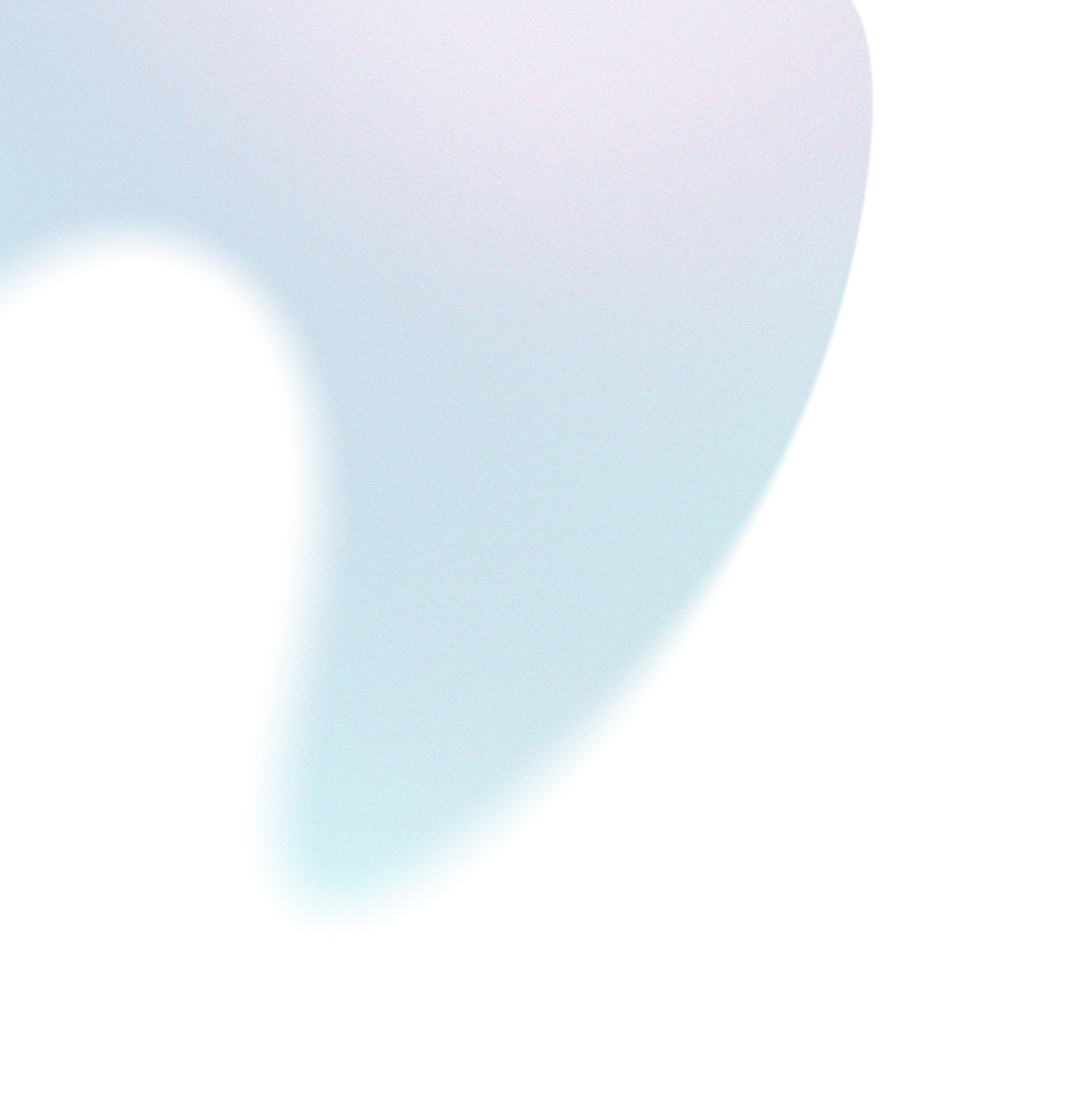How To Use Klaviyo Like A Pro – 2024 Complete Guide
1. Create an email Building an email in Klaviyo is extremely simple with their drag and drop builder. You can also follow the same steps below to create an email for a flow since their email builder is the same...
Tags
Tools
Level
Related Partners

1. Create an email
Building an email in Klaviyo is extremely simple with their drag and drop builder. You can also follow the same steps below to create an email for a flow since their email builder is the same for both types of emails.
To get started with creating an email in Klaviyo, click on “Email Templates” then click “Create Template”. This will bring you to their email builder. This is a good way to get familiar with building an email in Klaviyo before learning to set up flows and send campaigns.
Here are the key elements to create emails that engages subscribers and converts customers:
Subject Line: The subject line is the main text an email subscriber sees in their inbox before they open the email. You want your subject lines to generate curiosity & interest for the reader to read the email.
Preview Text: The preview text is the additional information after the subject line that gives the reader more context on what the email is about within their inbox.
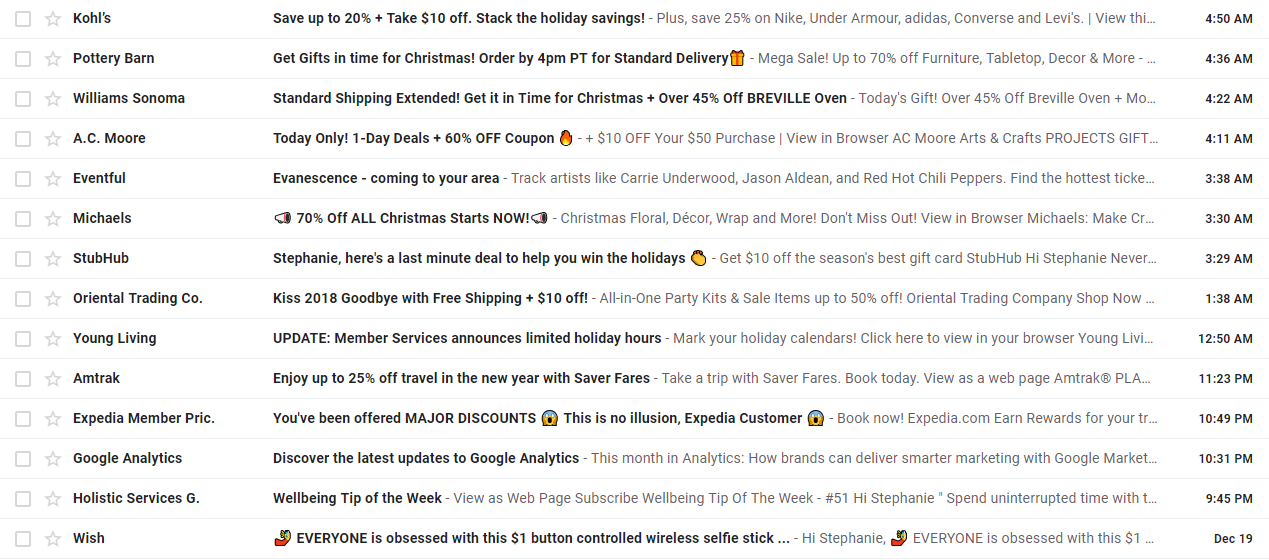
Navigation Bar: The navigation bar is typically in every email and directs the reader to key pages on your website.
Banner: A banner in an email is typically a short section above the header of the email to share more important or urgent information you want to draw readers’ attention to.
Header: The header is the first thing a recipient sees when they open an email so it’s important for it to be eye-catching and clearly communicate the purpose of the email. A header typically includes a call-to-action button directing the reader to your ecommerce store.
Body: The body is the main section of an email and contains the majority of the content such as images, text, and links to products. The body of an email should be well-organized, easy to read, relevant and valuable to the recipient.
Footer: The footer is the bottom section of an email and typically includes additional information such as the sender’s contact information, social media links, and links to unsubscribe or manage email preferences. The footer is important for compliance with the laws and regulations and also provide additional information that can be useful to the recipient.

You can find email templates in Klaviyo or use a tool like Backbone to generate customized email templates for each of your email campaigns flows.
2. Set up segments
In Klaviyo, segments are different types of audiences you can create. You can think of segments as different ways to group your email list.
For example, you can create a segment of only email subscribers who have made 2 purchases.
To set up a segment in Klaviyo, click on “Create List/Segment”, and select “Segment”.
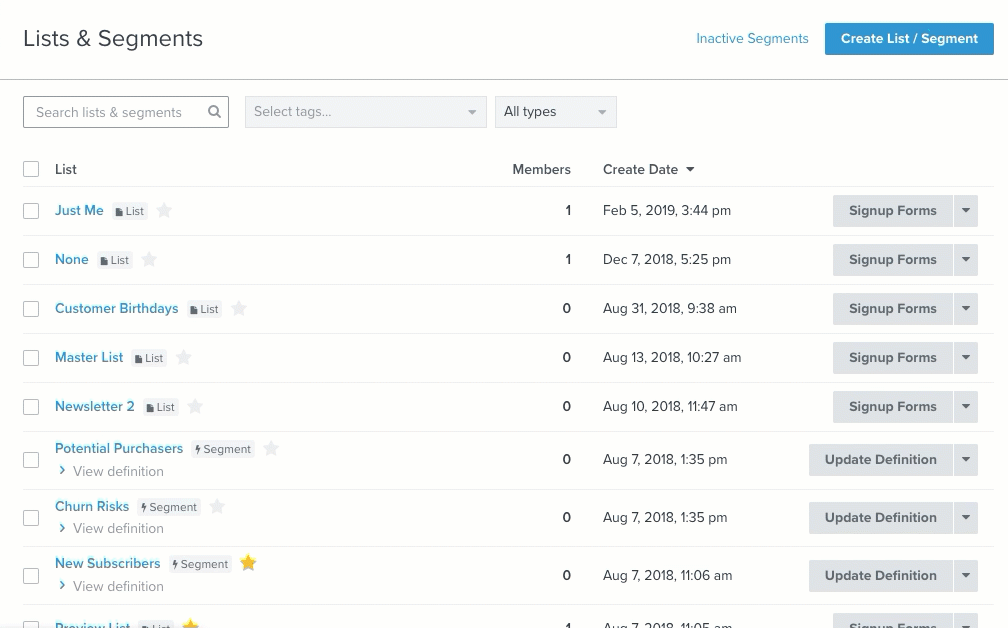
Segments are created from different types of audience properties and behaviors, which are called “conditions” in Klaviyo.
Properties are characteristics of your email subscribers, such as where they live or when they joined your email list. Common properties that you will use in creating segments are:
- Created: This is the date the individual joined your email list
- If someone is in or not a list: This is whether an individual is on a specific email list
- Behaviours are actions that your email subscribers do, such as opening an email or purchasing a product. When creating a segment in Klaviyo, you can select behaviours using the “what someone has done or not done” condition. A few common behavioral data you will use are:
- Has or has not made a purchase
- Has or has not opened an email in _____ days
- Has or has not clicked an email in _____ days
Here are a few basic segments you’ll want to create in your Klaviyo account to start:
- Broad Audience (Opened 1x L180): This is a segment of email subscribers who have opened or clicked an email in the last 180 days
- Engaged (Open 1x L90): This is a segment of email subscribers who have opened or clicked an email in the last 90 days
- Engaged Recent Purchasers (Open 1x L90): This is a segment of email subscribers who have opened or clicked an email in the last 90 days & have made at least once purchase
- Engaged Non-Purchasers (Open 1x L90): This is a segment of email subscribers who have opened or clicked an email in the last 90 days & have never made a purchase
3. Send your first campaign
In Klaviyo, campaigns are manually sent marketing emails to a specific list or segment.
To build your first campaign, start by clicking on the “Create Campaign” button, select “Email Campaign” and name your campaign.

Next you’ll need to select who will receive the email. This is where you’ll select a specific email list or segment to send this email to.

It is generally a good practice to enable Smart Sending and Google Analytics. Smart Sending prevents email subscribers from receiving emails from you too often. Google Analytics tracking will integrate your Klaviyo email marketing data into Google Analytics automatically.
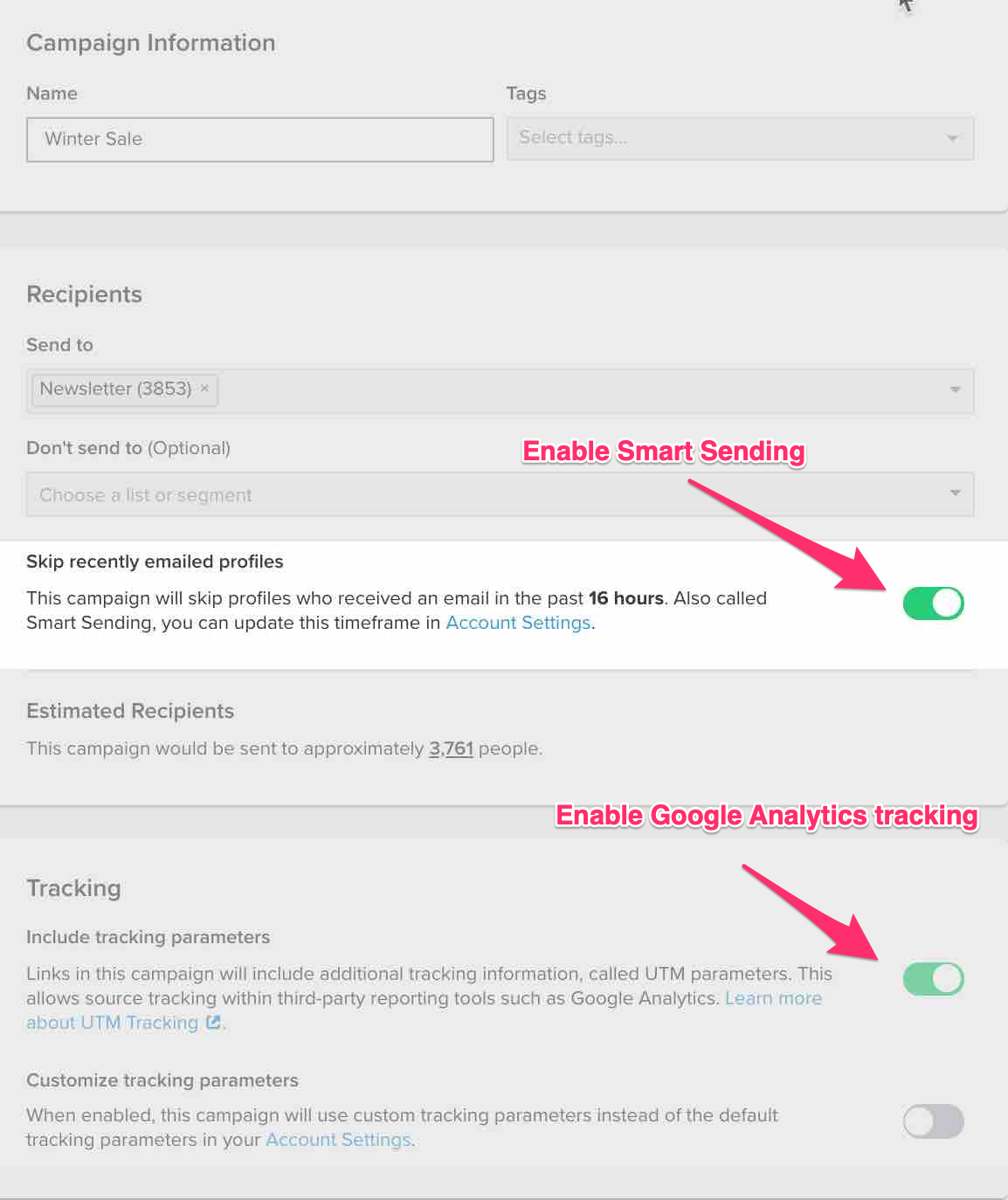
Next, you’ll move on to the Email Builder to create your campaign, where you can follow the steps in Step #1 of this article.
Lastly, select the time you want to schedule your campaign to be sent out, or send it out immediately.

4. Set up an email flow
Email flows are an incredibly important part of any successful email marketing strategy because they generate automated revenue for your ecommerce store.
To set up an email flow, first navigate to your Klaviyo account and click the “Create Flow” button. You can also select “Browse Ideas” to look through Klaviyo’s Flow Library which as pre-built flow templates.

Next, you’ll need to configure your flow. There are a few key elements to setting up your flow properly:
Flow Trigger: The flow trigger determines what sets the flow in motion & gets a subscriber to enter the flow. For example, a flow that is triggered by the metric “Added To Cart” means that a subscriber will enter the flow when the add a product to cart.
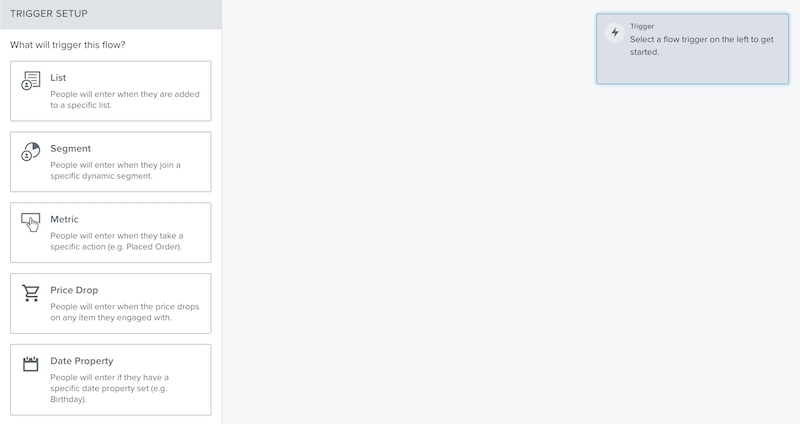
Klaviyo provides a few different types of triggers. These are the 3 most common ones you’ll get started with:
- List-triggered: Triggers when someone is added to a specific email list.
- Segment-triggered: Triggers when someone is added to a specific segment.
- Metric-triggered: Triggers when someone takes a specific action.
Flow Filters: The flow filter determines which subscribers enter the flow. For example, the same flow with the filter “has placed an order zero times over all time” means that a subscriber will only enter the flow if they have never made a purchase.

Klaviyo provides a few different types of triggers. These are the most common flow filters you’ll use:
- Has placed an order _____ times over all time: This determines whether you want non-purchasers, one-time purchasers, or returning customers to enter the flow.
- Has entered the flow ______ times in the last _____ days: This determines how often you want someone to enter the same flow.
- Has placed order 0 times since entering this flow: This determines whether customers should exit the flow once they’ve made a purchase
Next, you’ll start adding steps to the flow by adding in emails & delays. This determines what and when emails are sent to subscribers who enter the flow.
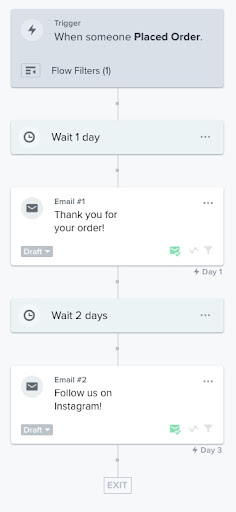
Lastly, you’ll start building each of the emails within the flow using Klaviyo’s email builder. You can find email templates in Klaviyo or use a tool like Backbone to generate customized email templates for each of your flows.
Here are the top 8 flows all ecommerce brands should set live first to generate predictable, automated revenue:
- Welcome Flow: Introduces email subscribers to your brand & converts them to make their first purchase. Learn more about how to build an effective Welcome Flow here.
- Browse Abandoned Flow: Converts shoppers who are browsing your products into customers. Learn more about how to build an effective Browse Abandoned Flow here.
- Add To Cart Flow: Converts shoppers who are adding products into their cart into customers. Learn more about how to build an effective Add To Cart Flow here.
- Abandoned Cart Flow: Converts shoppers who are starting checkout into customers. Learn more about how to build an effective Abandoned Cart Flow here.
- Post-Purchase Nurture Flow: Thanks customers after they’ve made a purchase and nurtures them. Learn more about how to build an effective Post-Purchase Nurture Flow here.
- Replenishment Flow: Reminders customers to repurchase a product they may be running out of. Learn more about how to build an effective Replenishment Flow here.
- Cross-Sell Flow: Introduces customers to other products they may like to get them to make another purchase. Learn more about how to build an effective Cross-Sell Flow here.
- Winback Flow: Re-engages customers who have not made a purchase in a while. Learn more about how to build an effective Cross-Sell Flow here.
Many of these flows are also available as a pre-built flow in Klaviyo’s Flow Library. You can use a tool like Backbone to build you a customized email flow plan & flow email templates for your business.
5. See your email marketing performance
Obviously, once you’ve sent some emails, you’ll want to be able to see how your email marketing campaigns and flow perform!
Navigate to Klaviyo’s Dashboard and click “Performance” to see a high-level summary of your email marketing performance.
Here you can see the total amount of revenue you have generated from Klaviyo and the percentage that it makes up of your total ecommerce store revenue. You can also see a summary of each of the email flows and the amount of revenue they have generated.
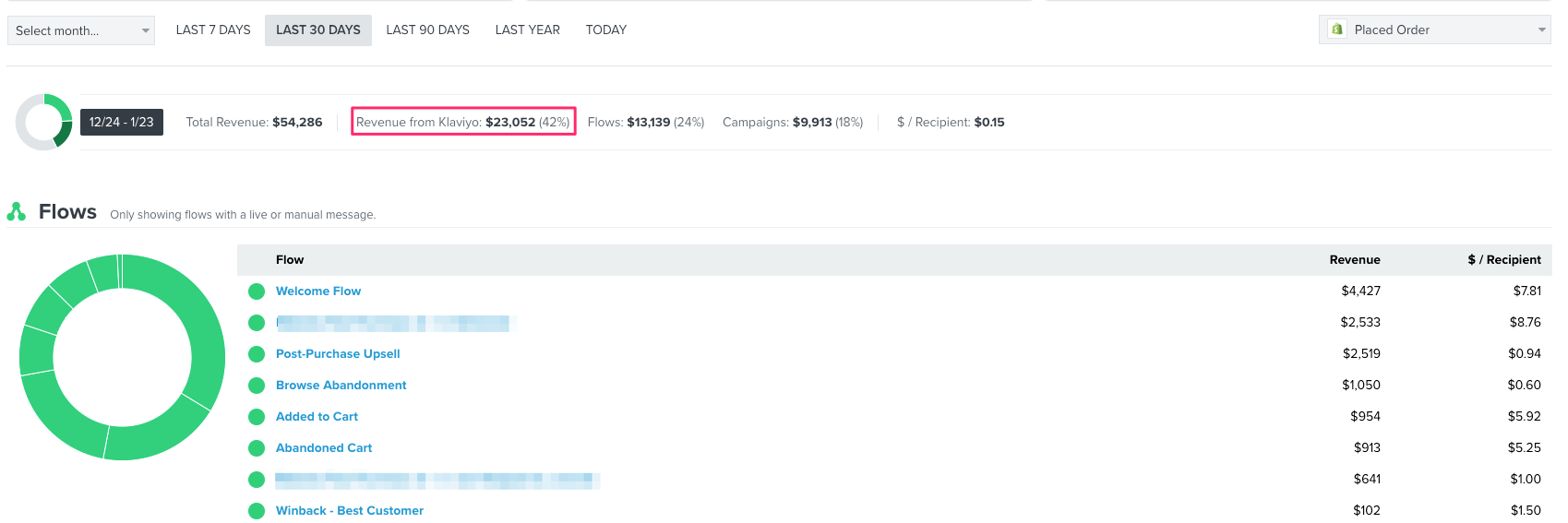
To see your email campaign performance, click on the “Campaigns” tab. Here you’ll be able to see a summary of your average engagement & revenue per recipient for your campaigns. You can also see a list of all the campaign you have sent, along with their open rate, click rate and revenue.
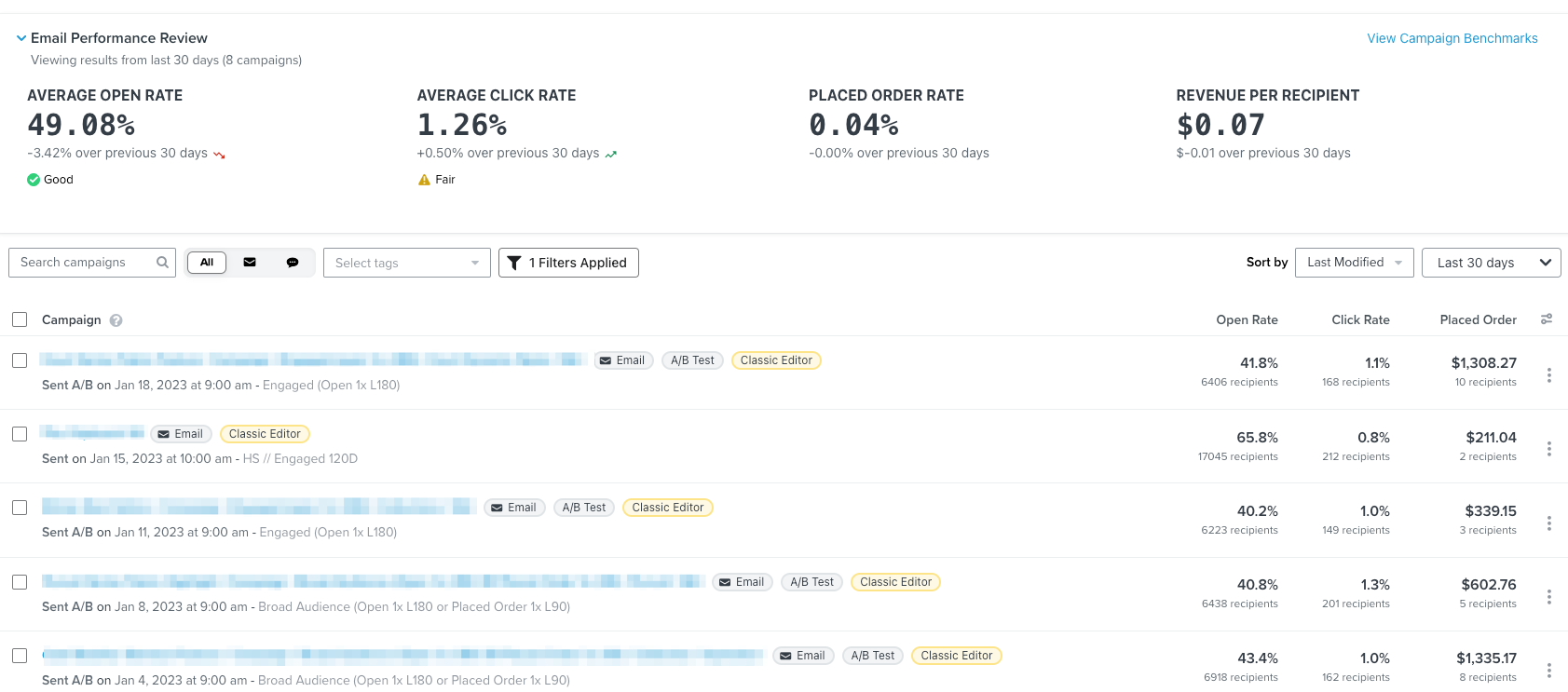
You can also click on any campaign to see more detailed performance of each individual campaign.
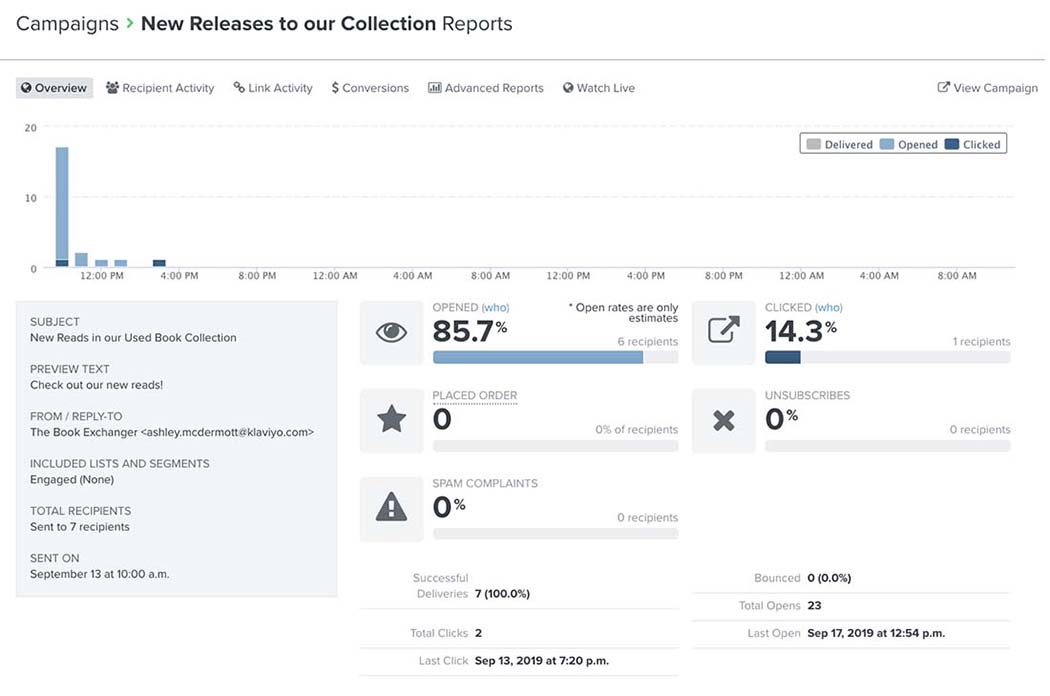
Becoming an Klaviyo Pro
As you progress in your email marketing skills, it is important to not only know how to use an email marketing automation platform like Klaviyo, but also how to build & execute a strategy that can effectively generate revenue from email marketing.
Our Beginner’s Guide To Email Marketing covers everything you need to start doing email marketing for your ecommerce brand.
Here is a summary of the top skill sets you need to master to become a great email marketer:
Building & Optimizing Email Flows
Email flows should make up between 10-20% of all of the revenue for your ecommerce store. So mastering the strategy to build and optimize email flows is a critical skill for any email marketer. You want to start by making a list of all the email flows your ecommerce store needs, then building each of the emails in the flow.
You can use a tool like Backbone which will automatically create a prioritized list of email flows for your business along with customized email layouts.
Planning Email Marketing Calendars
Your email marketing calendar is your hub to plan and execute all of your email marketing projects. In other words, it is a plan for all the email campaigns and flows you will create and send each month. You want to plan an email marketing calendar each month that includes promotions, product launches, seasonal campaigns and email flows that you will be building and sending each day of the month.
You can use a tool like Backbone which will automatically generate a custom email marketing calendar for your ecommerce store each month easily.
Designing Emails That Convert
Lastly, as an email marketer, you want to make sure you’re sending emails that engage your email subscribers and convert them into customers. This means designing emails that are eye-catching and optimized to get clicks and conversions. Pay attention to the layout and design of your emails and A/B test constantly to improve these metrics.
You can use a tool like Backbone which will automatically create a customized email layout for each of your campaigns and flows, that you can then export to Figma to design conversion-optimized emails.
A white-glove service built for success.
We've planned every part of your client experience so you know you're in good hands.
Related Posts

Post-Purchase Nurture Flow
The Post-Purchase Nurture Flow maintains engagement by thanking customers, educating customers on how to use the product & sharing content relevant to their challenges. It targets recent buyers, fostering a post-purchase relationship that enhances customer loyalty and lays the groundwork for repeat business.What’s A Post-Purchase Nurture Flow?A Post-Purchase Nurture Flow is the first few emails a customer gets after they make a purchase (besides transactional emails like an Order Confirmation). This is one of the most commonly underused but important emails for a DTC ecommerce brand because it builds brand loyalty with purchasers.The best way to keep customers is to make sure they have a great experience of your brand and products, so they return to make future purchases.That’s why building a great Post-Purchase Nurture flow is the first step to retaining more customers, getting more repeat purchases & increasing customer lifetime value (LTV). An effective Post-Purchase Nurture builds brand loyalty by thanking customers, educating them on how to get the most of your products.# Of Emails: 5Flow Length: 10-15 daysWhat’s the goal of a Post-Purchase Nurture Flow?To nurture customers to become repeat customers & raving fans which:Increases your repeat purchase rate by getting more customers to return to make additional purchasesGets...

The 1-2 Punch: How to Combine Direct Mail & Email Marketing to Nurture, Convert & Retain Customers
Instagram and avocado toast. Mario and Luigi. Email and direct mail. Think one of these pairs doesn’t belong? Wrong. They’re all things that work beautifully together. Email and direct mail aren’t competitors; they’re complimentary channels in a smart ecommerce marketing portfolio. Together they can help nurture leads, convert customers and increase customer lifetime value. How Direct Mail and Email Marketing Stack UpBefore you start layering direct mail and email marketing together, it’s important to understand the strengths of each channel. Email and direct mail have some significant similarities. Both are trackable and can be automated. Both enable one-to-one personalization—you can customize everything from greetings to visuals to discount codes. The big differences between email and direct mail are in reach, response, speed and cost. One isn’t better than the other—they have advantages that complement one another, which it’s why it’s smart to use them in concert. Reach: Email is easy to send and has a broad reach. Open rates generally max out around 30%. Direct mail has an estimated 90% open rate, because there’s less competition in physical mailboxes. Response: According to Campaign Monitor, the average email click-through rate is 2.3%, which means volume is important. The Data & Marketing Association shows an average 9% response rate for direct mail campaigns,...

The Guide to Email Marketing KPIs: How to Measure and Optimize Your Email Campaigns
Like most marketing channels, growing your email revenue is a process of continual growth and optimization. Once you're regularly sending out email campaigns, your email marketing KPIs will tell you where there is room to optimize, try new campaign ideas, and run A/B tests. E-commerce brands often leave thousands of dollars of revenue on the table because they don't regularly review their performance & optimize their email marketing strategy based on their insights. Sometimes, something as simple as a different send time or a change in the email layout can create 15-20% more lift in revenue. Sometimes, your email marketing KPIs will help you identify new types of email marketing campaigns that your subscribers engage with more.Another common mistake e-commerce brands make is sending out the same few email marketing campaigns each month, which eventually end up feeling repetitive to subscribers. Regularly measuring & optimizing your campaigns includes coming up with new ideas to test.To make the most out of your email marketing efforts, every e-commerce brand should follow this process:Send Email CampaignsUpdate A Weekly Reporting DashboardAnalyze the data at least once a month (ideally weekly!)Identify opportunities for A/B tests, segmentation, and other campaign ideasDeploy new tests & ideas on...

Mastering the Art of Email Marketing: Best Practices for Success
Email marketing is one of the essential marketing channels that every direct-to-consumer (DTC) e-commerce brands needs to master to grow their revenue, drive conversions, retain customers & build a sustainable, scalable business. With this guide, you'll be able to get from zero to launched & start driving revenue from email marketing. We'll break down the email marketing best practices, from planning your campaigns to analyzing the results.Don't have time to master email marketing yourself?Get started with Backbone to get a custom-built email marketing strategy & email layouts for your business, all based on email marketing best practices.Book Your DemoPlanning Your Email CampaignDefining Your ObjectivesRevenue is always the end goal for any DTC e-commerce brand, but how will this email campaign drive revenue? Before launching your email marketing campaigns, start by defining the objective of the campaign.Here are a few different ways that email campaigns drive revenue:By announcing something new & exciting (such as a promotion, product launch or collaboration)By creating urgency (such as a limited edition product selling out or a promotion ending)By educating customers (such as content emails & seasonal tips)By showing how your product can solve a customer's problems (such as showing how your product works)By showing the benefits of your product...

From Idea To Launch: How To Create A Successful Email Marketing Campaign – 2024 Guide
Email marketing is a powerful tool that can help ecommerce stores nurture, convert & convert potential customers. In fact, email marketing should be generating 20-30% of the total revenue for your ecommerce store.However, creating an effective campaign that converts customers & generates revenue requires more than just adding images & copy to an email template.In this guide, we will walk you through the step-by-step process of building & launching an email marketing campaign from idea to launch. This email workflow will help you build an email marketing strategy for your campaign, write engaging copy, design an email that converts, and send it to the right audience.You'll also learn actionable tips to help you create campaigns that drive engagement and revenue for your business. Whether you're new to email marketing or a seasoned pro, this guide will give you the tools and knowledge you need to create successful campaigns that drive results.Step 1 // Email Brief: Building Your StrategyThe first step in creating a successful email marketing campaign is to develop an email brief. This is typically done by the Email Marketing Manager or the Head of Marketing. An email brief is a document that outlines the key information for your...

Building An Email Marketing Team: The 6 Roles Of A Dream Team
Often ecommerce stores grow from 6-figure to 7-figure & 8-figure companies before they wish they had invested more into email earlier on. Often this means ecommerce stores are easily leaving hundreds of thousands of dollars on the table.Email marketing is a powerful tool for any business, and it's essential to have the right team in place to maximize its potential.But what does an effective email marketing team look like?From the strategic planner to the creative designer, each role plays a vital part in building a team that can strategize, create and execute effective email campaigns that drive engagement and revenue.By understanding these roles and how they work together, you'll be able to build a team that can take your email marketing efforts to the next level.Here we'll explore the 6 key roles that make up a dream email marketing team, and how each role contributes to the success of your email marketing efforts:1. The Email Marketing ManagerA successful Email Marketing Manager also known as an Email Strategist, is able to develop and implement a comprehensive email marketing strategy that aligns with the overall business goals, and consistently delivers results in terms of email engagement, conversions and revenue.They lead and manage...

The 6 Most Important Email Marketing Metrics You Should Be Measuring For Your Ecommerce Store
Email marketing is an essential aspect of any e-commerce business, and it's important to have the right metrics in place to measure the success of your email marketing efforts.One of the most important (and often overlooked) steps in executing a successful email marketing strategy is analyzing how your customers respond to your emails and applying what you learn along the way.But most companies only track open and click rates or the total revenue coming from their emails. The problem is, this doesn’t paint the full picture of how their email marketing is directly affecting their bottom line nor provide actionable insights to improve email performanceHere are the most 6 important email marketing metrics that e-commerce brands should be measuring to ensure that their campaigns are effective and driving revenue:1. Percentage of RevenueLet’s say you’re making $10,000 from email every month. That sounds pretty great right?Maybe.It is, if your ecommerce store is generating $30,000 in revenue per month. But it's a sign of underperformance if your ecommerce store is generating $150,000 in revenue per month.Most ecommerce stores make the mistake of only tracking total email marketing revenue.Instead, monitor how big a slice of your revenue pie is coming from email marketing and adjust...

How To Setup Klaviyo In 15 Minutes – 2024 Complete Guide
What is Klaviyo?Klaviyo is an all-in-one email marketing automation platform that allows e-commerce businesses to create and send highly targeted email campaigns, track customer behavior, and analyze the performance of your campaigns.With Klaviyo, you'll be able to generate more sales, increase customer engagement, and build sustainable growth. It seamlessly integrates with your e-commerce store, making it super easy to automate & personalize those important follow-up emails, like abandoned cart reminders and personalized product recommendations.Using a marketing automation platform like Klaviyo is absolutely critical for all ecommerce brands in 2024.Is Klaviyo the best email marketing automation platform for my ecommerce brand?If you're a DTC ecommerce store owner, you know that choosing the right email marketing platform is crucial for your business success.While there are several options available, such as MailChimp, Active Campaign and others, Klaviyo stands out as the best choice for e-commerce stores for a few reasons:Automation: Klaviyo's automation capabilities are specifically designed for e-commerce businesses, making it easier to set up and execute targeted campaigns, such as abandoned cart reminders or personalized product recommendations, which can increase conversions and boost sales.Segmentation: Klaviyo's segmentation features are more advanced compared to its competitors, allowing you to create highly targeted campaigns and send messages...

Welcome Flow
The Welcome Flow is a series of emails to greet new email subscribers. It builds trust & generates revenue by sharing your brand story, introducing them to your products & encouraging them to make their first purchaseWhat’s A Welcome Flow?A Welcome Flow is the first point of contact between your brand and a new email subscriber subscriber. Once a website visitor opts-in to your email list through your website pop-up, the Welcome Flow introduces the lead to your brand & products.# Of Emails: 5Flow Length: 5-10 daysWhat’s the goal of a Welcome Flow?To get non-purchasers to make their first purchase by introducing them to the brand & guiding them towards the product(s) they should purchase which:Converts more new email subscribers into paying customers (which means more revenue!)Gets potential customers to make their first purchase faster (ie. the amount of time it takes someone to go from being aware of the brand to becoming a customer)Gets more revenue out of each lead you drive to your website (which means lower CPAs & more value from your website traffic)Generates a higher average order value (AOV) for first-time customers by introducing them to more products that they may be interested inWelcome Flow EmailsEmail #1: WelcomeAn email to welcome...

Setting Up Klaviyo Back In Stock Flows For Easy Sales
30 Second Summary1. A Back In Stock flow is important if your e-commerce brand often runs out of stock or has limited runs on products. It turns interested shoppers into customers, and is a way to turn inventor management challenges into a marketing opportunity.2. To start off, build a Back In Stock flow by integrating your e-commerce platform, creating a "Back In Stock" button on your product page & setting up the flow in Klaviyo3. A standard back in stock flow should have 1-3 emails sent over 3-7 daysThese flows, integrated with your e-commerce platform, capture customers' interest when a product is out of stock and keep them engaged via 1-3 automated emails sent over a 3-7 day period.One of the opportunities e-commerce brands often miss out on are converting shoppers who are interested in a product that's out of stock. Without a Back In Stock Flow in Klaviyo to capture the lead, cross-sell products, and notify customers for existing inventory drops, your e-commerce store is losing these potential customers.A Klaviyo Back In Stock is more than just a transactional reminder for customers. It can be an incredible revenue-generating flow for your e-commerce brand if you have often have products...
